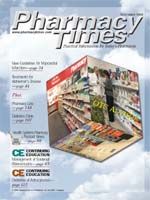Publication
Article
Pharmacy Times
Multistep Approach to the Treatment of CAD
Author(s):
Coronary artery disease (CAD) isthe most prevalent type ofheart disease, affecting approximately13 million individuals in theUnited States. It is considered to be thenumber-1 killer among both men andwomen.1 It is the end result of atherosclerosis,which occurs when the arteriesthat supply blood to the heart musclebecome hardened and narrowed asthe result of an accumulation ofplaque in the inner walls or the lining.The flow of blood to the heart isdiminished due to this narrowing, andthus the supply of oxygen to themyocardial tissue is decreased. Overtime, the plaque can completelyobstruct blood flow to the myocardialtissue or cause the formation of bloodclots that can lead to myocardialinfarction (MI).
CAD can begin as early as childhoodand can develop over many years. Themajor complications of CAD, in additionto MI, are angina pectoris, unstableangina, and arrhythmias, whichmay cause sudden death. Yet, 25% to30% of all individuals in the earlystages of CAD are asymptomatic andare experiencing "silent ischemia."2
CAD is very prevalent in individualsover the age of 70, and it is oftenthought to be misdiagnosed or underdiagnosedin this patient population.3The risks of developing CAD are notexclusively an unavoidable result ofthe aging process but are directly relatedto lifestyle and environmental factors.The likelihood of developing CADis dependent on certain risk factors,some of which can be controlledwhereas others cannot (Tables 1 and 2).
Signs and Symptoms
The signs and symptoms of CAD canvary. In some individuals, an MI is thefirst sign of CAD. Other common signsinclude chest pain or angina, dyspneaupon exertion, or episodes of fatigue.Signs of angina in men may includepain felt behind the breastbone thatmay radiate up to the left arm, neck,shoulder, elbow, jaw, or back. Some individualsmay exhibit atypical symptomssuch as indigestion, excessive sweating,or nausea. Atypicalsymptoms are verycommon in women.
Diagnosis
Various diagnostictests are used to determinewhether an individualhas CAD, alongwith an evaluation ofthe individual's symptoms,risk factors, andgenetic history. Thetests typically performedinclude thefollowing:
- Hematologic analysis
- Electrocardiogram
- Exercise stress test
- Coronary angiography (arteriography)
- Coronary magnetic resonance angiography
- Nuclear scan
- Echocardiogram
- Electron beam computerized tomography
Recently, the FDA approved themarketing of the PLAC test, a laboratoryblood test that, when used in conjunctionwith a clinical evaluation, canpredict an individual's risk of CAD.Because nearly 50% of individuals whohave heart attacks have normal low-densitylipoprotein (LDL) levels, thistest can be beneficial in predictingrisks. The PLAC test measures lipoprotein-associated phospholipase (A2, Lp-PLA2). Any sign of elevation indicatesan increased risk of CAD.4
Goals of Treatment
Pharmacists can play an effective rolein the management of CAD by having athorough understanding of both thepathophysiology and the pharmacologyof CAD. A multistep approach oftenis utilized in the treatment of CAD,which includes pharmacologic agents,lifestyle modifications, and special invasiveprocedures. The goals of treatmentinclude the following:
- Reduction of cardiovascular events
- Relief of symptoms of CAD
- Slowing of the progression of atherosclerosis by controlling risk factors
- Widening or bypassing narrowed arteries
- Decreasing myocardial oxygen demand and/or increasing oxygen supply
Pharmacologic Therapies
The choice of pharmacologic therapiesis dependent on the patient's medical history and the extent of CAD. Inthe geriatric population, decreasedhepatic and renal functions should beconsidered when selecting appropriatepharmacologic therapies and dosingregimens to reduce the incidence ofadverse effects and/or toxicity. Becausethese patients tend to have multipledrug regimens and other disease states,they should be screened for potentialdrug?drug interactions and contraindications.
Nitrates
Currently, various nitrate productsare available for the treatment of angina.Long-term usage of nitrates maylead to the development of toleranceto their pharmacologic effects. This tolerancemay be prevented by establishing"nitrate-free" periods. Abrupt withdrawalshould be avoided so as todecrease the chances of precipitatingan angina attack. Tapering the doseover time is recommended.
Beta-Blockers
Beta-blockers have been in use sincethe 1970s and have been very advantageousin the treatment of CAD. Theyexert their therapeutic effect by competitiveinhibition of betaadrenergicreceptors, thus causingreduction in cardiac rate and contractibilityand therefore de-creasingmyocardial oxygen demand. Beta-blockersshould be avoided particularlyin elderly populations and in thosewith chronic obstructive pulmonarydisease, diabetes, and congestive heartfailure (CHF). Otherwise, beta-blockerstend to be well-tolerated by otherpatient populations.
Calcium Channel Blockers
Calcium channel blockers such asverapamil, diltiazem, and nifedipineaid in treating CAD because they causeperipheral dilation, producing adecrease in afterload and hence areduction in myocardial oxygendemand. In general, adverse effectsassociated with calcium channel blockersstem from their therapeutic effectand may include peripheral edema,hypotension, and constipation. In theelderly population, constipation tendsto be troublesome and needs to bemonitored.
Antiplatelet Drugs/Anticoagulants
Antiplatelet drugs such as aspirin,glycoprotein IIb/IIIa inhibitors,thienopyridines, and anticoagulants(eg, warfarin and heparin) are verybeneficial in preventing the formationof thrombi or emboli. Low-dose aspirinis the first line of defense in preventingMIs in patients with stable angina or inthose with risk factors. Aspirin alonehas been reported to reduce the risk ofan MI by 25% to 50% in men.5 Thesetherapies also pose the risk of bleedingdisorders, however.
Angiotensin-Converting EnzymeInhibitors
Angiotensin-converting enzyme(ACE) inhibitors are very useful intreating hypertension and usually arerecommended as an agent of choice inindividuals with diabetes, CHF, andrenal abnormalities. They exert therapeuticaction by inhibiting the breakdownof bradykinin, thus inhibitingthe conversion of angiotensin I toangiotensin II. They work by vasodilationwithout producing tachycardia.Due to the breakdown of bradykinin, adry hacking cough is a commonadverse effect. ACE inhibitors also cancause hyperkalemia.
Cholesterol-Lowering Agents
Because there is a strong correlationbetween hypercholesterolemia andCAD, the usage of antihyperlipidemicagents such as ezetimibe (Zetia; Merck/Schering-Plough), the fibrates (gemfibrozil),resins (cholestyramine), andniacin products commonly are used toreduce lipoprotein levels.
In the past few years, the managementof CAD has been enhanced bythe addition of 3-hydroxy-3-methylglutarylcoenzyme A (HMG-CoA) reductaseinhibitors, commonly knownas statins. These drugs include atorvastatin(Lipitor; Parke-Davis); pravastatin(Pravachol; Bristol-MyersSquibb); rosuvastatin (Crestor;AstraZeneca); simvastatin (Zocor;Merck); and lovastatin. These agentshave been utilized for both primaryand secondary prevention of CAD.They exert their pharmacologic effectby inhibiting HMG-CoA reductase,the rate-timing enzyme in cholesterolsynthesis, thus reducing LDL levels.Statins also can cause reductions intriglyceride levels and small elevationsof high-density lipoprotein.Common adverse effects include gastrointestinaldiscomfort, headaches,and nausea. Periodic hepatic-functionmonitoring is recommended, becausethese agents can cause elevation ofserum transaminase levels. Statins,however, have demonstrated theireffectiveness in reducing mortalityrates in relation to CAD.
Combination Therapy
In some cases of CAD, monotherapyis insufficient for controlling symptoms.Combining various pharmacologictherapies may be necessary to slowthe progression of CAD and to decreasethe incidence of cardiac events.
Invasive Procedures
In some cases of severe CAD, theuse of pharmacologic agents andlifestyle modifications are not effectiveand symptoms are not controlled.In these cases, angioplasty orcoronary artery bypass surgery maybe needed.
Conclusion
A thorough knowledge of the clinicalmanagement of CAD can aid pharmacistsin educating patients aboutreducing risk, improving outcomes bybeing compliant with their medicationregimen, and committing tolifestyle modifications. Pharmacistsalso can encourage younger patientsto make conscious decisions to reducethe progression of this cardiovascularmorbidity, through modifying anycontrollable risk factors and takingproactive measures to decrease risk.
Ms. Terrie is a clinical pharmacy writerbased in Slidell, La.
For a list of references, send a stamped,self-addressed envelope to: References Department,Attn. A. Stahl, Pharmacy Times,241 Forsgate Drive, Jamesburg, NJ 08831;or send an e-mail request to: [email protected].







